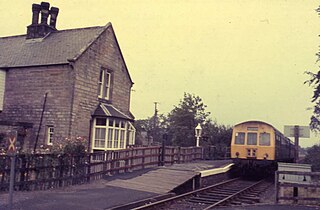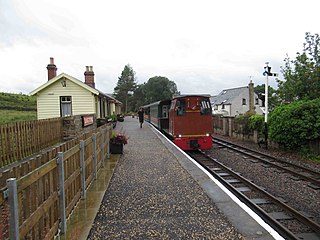Related Research Articles

South Gosforth is a Tyne and Wear Metro station, and former British Rail station, serving the suburb of Gosforth, Newcastle upon Tyne in Tyne and Wear, England. It originally opened on 27 June 1864, as part of the Blyth and Tyne Railway, and became part of the Tyne and Wear Metro on 11 August 1980.

Fawdon is a Tyne and Wear Metro station, serving the suburbs of Fawdon and Kenton, Newcastle upon Tyne in Tyne and Wear, England. It was opened in 1981, adjacent to the level crossing carrying Fawdon Lane across the railway and with staggered platforms on either side of the level crossing.

Bank Foot is a Tyne and Wear Metro station, serving the suburbs of Woolsington and Kenton in the English city of Newcastle upon Tyne. It opened as a single platform terminal station in 1981, with the opening of the second phase of the metro, between South Gosforth and Bank Foot. It was restructured as a two platform through station in 1991, with the opening of the extension to Newcastle Airport.

Wansbeck Road is a Tyne and Wear Metro station, serving the suburbs of Coxlodge and Gosforth, Newcastle upon Tyne in Tyne and Wear, England. It joined the network on 10 May 1981, following the opening of the second phase of the network, between South Gosforth and Bank Foot.

Callerton Parkway is a Tyne and Wear Metro station, serving the hamlet of Black Callerton and suburb of Woolsington, in the English city of Newcastle upon Tyne. It is adjacent to a level crossing that carries Callerton Lane across the rail line. The station opened in 1991, following the opening of the extension of the Metro from Bank Foot to Newcastle Airport.

Airport is a Tyne and Wear Metro station, serving Newcastle International Airport, Newcastle upon Tyne in Tyne and Wear, England. It joined the network as a terminus station in 1991, following the opening of the extension from Bank Foot to Airport.
The Blyth and Tyne Railway was a railway company in Northumberland, England, incorporated by act of Parliament on 30 June 1852. It was created to unify the various private railways and waggonways built to carry coal from the Northumberland coalfield to Blyth and the River Tyne, which it took control of on 1 January 1853. Over time, the railway expanded its network to reach Morpeth (1857/8), North Seaton (1859), Tynemouth (1860/1), Newcastle upon Tyne (1864), and finally Newbiggin-by-the-Sea (1872). It became part of the much larger North Eastern Railway in 1874.

Kingston Park is a Tyne and Wear Metro station, serving the suburb of Kingston Park in the English city of Newcastle upon Tyne. It was opened in 1985, adjacent to the level crossing carrying Brunton Lane across the railway and with staggered platforms on either side of the level crossing.

Regent Centre is a Tyne and Wear Metro station in Zone B, serving the suburb of Gosforth, Newcastle upon Tyne. It joined the network on 10 May 1981, following the opening of the second phase of the network, between South Gosforth and Bank Foot.

Tyne and Wear is a metropolitan area covering the cities of Newcastle upon Tyne and Sunderland, as well as North and South Tyneside, Gateshead and Washington.

Coxlodge is an area situated between Fawdon, Gosforth and Kenton in Newcastle upon Tyne, in the county of Tyne and Wear, England. Until 1974 it was in Northumberland.

The Ponteland Railway was a 7-mile (11 km) single-track branch line, which linked Gosforth in Tyne and Wear with Ponteland in Northumberland. A 1+1⁄4-mile (2 km) sub-branch line also ran between Ponteland and Darras Hall.

Kenton Bank was a railway station on the Ponteland Railway, which ran between South Gosforth and Ponteland, with a sub-branch line to Darras Hall. The station served Kenton in Newcastle upon Tyne. It was opened in 1905 as Kenton, renamed in 1923, and was closed to passengers in 1929, and to goods traffic in 1965.

Featherstone Park was a railway station on the Alston Branch Line, which ran between Haltwhistle and Alston. The station, situated 3 miles (5 km) south-west of Haltwhistle, served the villages of Featherstone and Rowfoot in Northumberland.

South Gosforth Traction Maintenance Depot is a vehicle cleaning, maintenance and stabling facility used by the Tyne and Wear Metro, located in Gosforth, Newcastle upon Tyne in Tyne and Wear, England.

Darras Hall was a railway station on the Ponteland Railway, which ran between South Gosforth and Ponteland, with a sub-branch line to Darras Hall. The station served Darras Hall in Northumberland.

Ponteland was a railway station on the Ponteland Railway, which ran between South Gosforth and Ponteland, with a sub-branch line to Darras Hall. It served Ponteland in Northumberland.
Coxlodge was a railway station on the Ponteland Railway, which ran between South Gosforth and Ponteland, with a sub-branch line to Darras Hall. The station served Coxlodge and Fawdon in Newcastle upon Tyne. It was opened in 1905, closed to passengers in 1929, and to goods traffic in 1965.
West Gosforth was a railway station on the Ponteland Railway, which ran between South Gosforth and Ponteland, with a sub-branch line to Darras Hall. The station served Gosforth in Newcastle upon Tyne.

Slaggyford was historically a railway station on the Alston Line, which ran between Haltwhistle and Alston. The station served the village of Slaggyford in Northumberland.
References
- ↑ Quick, Michael (2009). Railway Passenger Stations in Great Britain: A Chronology. Railway and Canal Historical Society. pp. 103, 131, 142, 234, 326 and 421. ISBN 978-0901461575.
- 1 2 Young, Alan (17 May 2017). "Disused Stations: Callerton". Disused Stations. Retrieved 27 December 2017.
- ↑ Bradshaw's Railway Guide (Reprint ed.). London: Guild Publishing. 1985 [1922].
- ↑ Quick, Michael (2009). Railway Passenger Stations in Great Britain: A Chronology. Railway and Canal Historical Society. p. 103. ISBN 978-0901461575.
- ↑ Hoole, Ken (1987). The North Eastern Electrics. The Oakwood Press. ISBN 0 85361 358 3.
- ↑ "Metro's airport extension celebrates its 25th year". Nexus. 17 November 2016. Retrieved 24 May 2020.
- ↑ Houlison, Sam (16 November 2016). "The Metro to the airport opened 25 years ago". ChronicleLive. Retrieved 14 November 2020.
- ↑ "Callerton Parkway" (Map). RailMapOnline. Retrieved 13 October 2024. Use 'Layers' tab to add stations and their labels to the map to see the original station location.